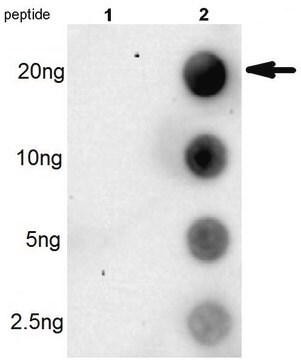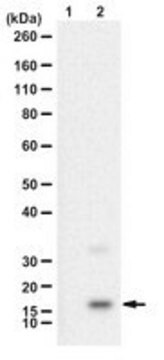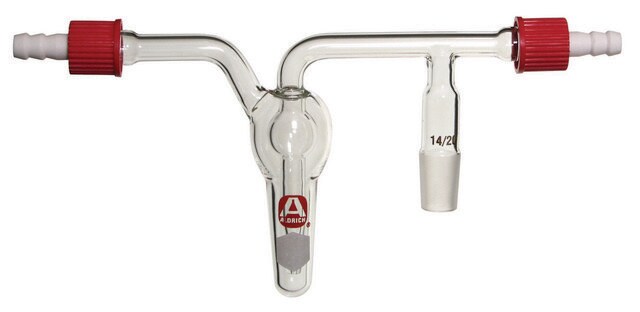ABE2605
Anti-H3K4me3Q5histaminyl
Synonim(y):
Histon H3 trimetylowany lizyną 4 Histaminylowana glutamina5
About This Item
Polecane produkty
pochodzenie biologiczne
rabbit
Poziom jakości
białko sprzężone
unconjugated
forma przeciwciała
purified antibody
rodzaj przeciwciała
primary antibodies
klon
polyclonal
masa cząsteczkowa
calculated mol wt 15.51 kDa
reaktywność gatunkowa
human
opakowanie
antibody small pack of 100 μg
metody
dot blot: suitable
western blot: suitable
izotyp
IgG
sekwencja epitopowa
N-terminal
numer dostępu Protein ID
numer dostępu UniProt
Warunki transportu
ambient
docelowa modyfikacja potranslacyjna
trimethylation (Lys4), histaminylation (Gln5)
informacje o genach
human ... HIST3H3(8290)
Opis ogólny
Specyficzność
Immunogen
Zastosowanie
Oceniono za pomocą analizy DOT Blot z peptydem K3K4me3Q5Histaminyl.
Analiza Dot Blot: Rozcieńczenie 1:1000 tego przeciwciała wykryło peptyd H3K4me3Q5Histaminyl, ale nie niezmodyfikowany peptyd H3Q5.
Testowane aplikacje
Analiza Western Blotting: Rozcieńczenie 1:2000 z reprezentatywnej partii wykryło histon H3.1 trimetylowany na lizynie 4 i histaminylowany na glutaminie 5 (H3K4me3Q5Histaminyl) w lizatach całych komórek RN46A, KU812, SK-N-SH i HEK293T. (Dane udostępnione dzięki uprzejmości Dr. Ian Maze s Lab, Icahn School of Medicine at Mount Sinai, Nowy Jork).
Uwaga: Rzeczywiste optymalne rozcieńczenia robocze muszą być określone przez użytkownika końcowego jako próbki, a warunki eksperymentalne mogą się różnić w zależności od użytkownika końcowego.
Postać fizyczna
Przechowywanie i stabilność
Inne uwagi
Oświadczenie o zrzeczeniu się odpowiedzialności
Nie możesz znaleźć właściwego produktu?
Wypróbuj nasz Narzędzie selektora produktów.
Kod klasy składowania
12 - Non Combustible Liquids
Klasa zagrożenia wodnego (WGK)
WGK 1
Temperatura zapłonu (°F)
Not applicable
Temperatura zapłonu (°C)
Not applicable
Certyfikaty analizy (CoA)
Poszukaj Certyfikaty analizy (CoA), wpisując numer partii/serii produktów. Numery serii i partii można znaleźć na etykiecie produktu po słowach „seria” lub „partia”.
Masz już ten produkt?
Dokumenty związane z niedawno zakupionymi produktami zostały zamieszczone w Bibliotece dokumentów.
Nasz zespół naukowców ma doświadczenie we wszystkich obszarach badań, w tym w naukach przyrodniczych, materiałoznawstwie, syntezie chemicznej, chromatografii, analityce i wielu innych dziedzinach.
Skontaktuj się z zespołem ds. pomocy technicznej








